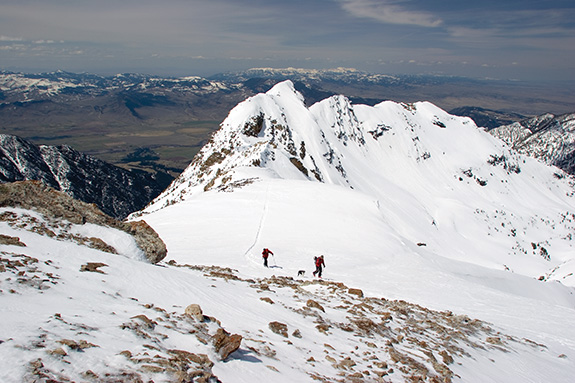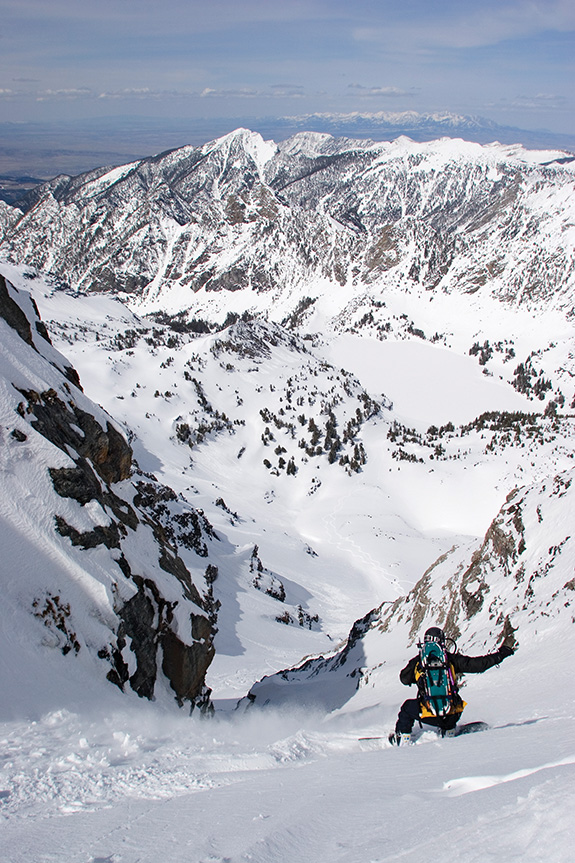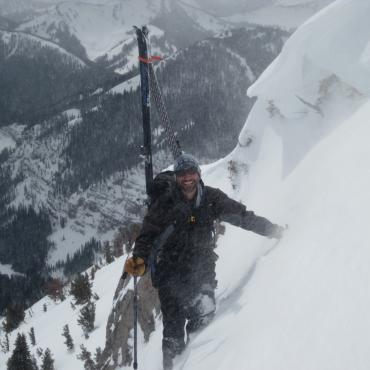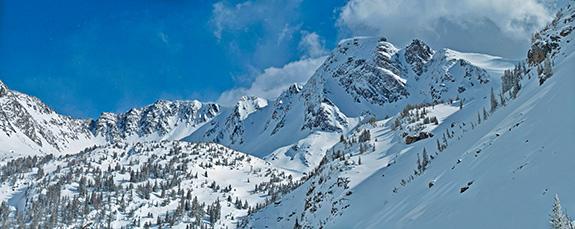Monochrome Massif
Ascending Black Mountain.
Black Mountain is the highest and most spectacular mountain in the Western Beartooths north of Mount Cowen. It owes its stature to the tremendous erosive power of Pine Creek and the Pleistocene glaciers that once gouged this spectacular canyon’s three forks. Credit must also be given to dramatic normal faulting along the western base of the range and in Pine Creek’s south fork, where the mammoth southwest face of Black rises 4,500 feet in less than two miles.
Neither Pine Creek’s south fork nor its lone eastern tributary contains an established trail; both have stunning meadows, colossal canyon walls, and superb north-facing glisse opportunities. Black Mountain is set back near the crest of its range and is not obvious when viewed from the south end of Paradise Valley. In fact, many have mistaken Mount Delano for Black because Delano protrudes westward toward Paradise Valley farther than Black, and the broad south sides of both mountains appear similar. Viewed from the northwest, however, Black is unmistakable, rising nearly 6,300 vertical feet from the Yellowstone River to its metallic summit helmet.
Black’s most alpine aspect is its rocky and icy north face, towering 1,900 feet above Pine Creek Lake, which is nestled in a spectacular hanging valley at the head of Pine Creek. Black Mountain’s relative remoteness would have made the mountain a much less-frequented climb had it not been for the excellent trail to Pine Creek Lake, which is perhaps the most popular hiking destination in the Western Beartooths. Black is thus a very popular one-day climb from communities throughout the northern ecosystem.
Black Mountain was first labeled on the 1925 Absaroka National Forest map and on a 1934 reprint of the Livingston 60-minute quadrangle. Although it was probably first climbed in the late 1800s, and many times in the early 1900s, there is no record of an ascent until 1948, when a USGS survey party cemented a bronze disk on the summit. Two years later, in October 1950, Ector B. Latham, Robert A. Pryce, and others climbed Black Mountain at the end of their whirlwind season in the northern Greater Yellowstone with the U.S. Coast and Geodetic Survey. This party broke camp after their ascent and led their horses down the steep Pine Creek Lake trail in a snowstorm that dumped a foot of snow. Other survey parties followed in 1951 and 1955. Bozeman mountaineer Dave Wessel was among the first locals to make the ascent, registering three visits during his lengthy climbing career.
Recent mountaineering on Black Mountain has mostly been in the form of glisse on the mountain’s north side. There, 2,000-foot ski runs can be made down moderate slopes, basins, and throughout a spectacular Y-shaped couloir that drops north off the summit ridge a short distance northwest of the summit. Doug Coombs made early ski trips to Black Mountain in 1981 and 1982, plucking descents of the western fork of the Y-couloir and steep bowl farther west. Coombs looked at the eastern branch of the Y-couloir and judged it too risky to ski.

Walking the dog on Black's west ridge
Another early skier on Black was free-heeler Derek Guastavson, who repeated Coombs’s west-branch descent in the late 1980s. Not until July 18, 1995 did the eastern branch of the Y-couloir yield to its first ski tracks. Tackling the route in thin summer-snow conditions, Hans Saari, with partners Aaron Blaker, Chris Bowman, and Matt Heller, described it as “sixty degrees for the first three turns then solid fifty.” Blaker described a crux section near the bottom where moats on either side of the couloir left a steep isthmus of snow less than a ski length wide.
Saari later returned with Alex Lowe and climbed the direct north face east of the Y-couloir and attempted to ski off the summit directly down the route they had climbed. The upper part of this route drops steeply on an exposed hanging snowfield, then veers west into a couloir on the lower part of the route. Saari and Lowe elected not to ski the route because the conditions consisted of an ice crust over slush. Instead, they skied off the summit down the northwest ridge and dropped into the 50-degree west branch of the Y-couloir, where Saari watched Lowe fall in the ice crust and self-arrest with one hand holding a Black Diamond Whippet!

Bill Hyland descends Black's Y-couloir
Ascent: The standard route up Black Mountain begins at Pine Creek trailhead. Three miles south of Livingston, turn east over a bridge across the Yellowstone River. Drive eight miles south along the foot of the mountains and turn east again onto Pine Creek Road (Forest Road #202), which leads three miles to the Pine Creek trailhead. The first mile of the trail to a beautiful waterfall slices through lush forest, reminiscent of the northwest, but with much drier mountains rising above. A pseudo-rainforest ecology exists in the canyons near Black Mountain because the flanks are so high and steep that little sun strikes the valley bottoms. Past the waterfall, the trail begins seemingly interminable switchbacks into the north fork of Pine Creek. This trail mostly ascends the north side of the canyon, and tackles three major headwalls en route to an extensive basin that holds Pine Creek Lake. Most first-time visitors to Pine Creek Lake are stunned by its sheer size, which is completely unexpected in such steep mountains.
While an ascent of Black Mountain is a delightful outing with spectacular scenery, a study of the beautiful and unique metamorphic rock around Pine Creek Lake is alone worth the effort of the strenuous hike. Just below the lake, the trail passes under large cliffs that from farther down-canyon appear terribly loose. Closer inspection reveals incipient gneiss, consisting of lightly metamorphosed, pimply, recrystallized sandstone striped with bands of marble patina. To the touch, the rock is mottled with knobs, pockets, and multi-colored veins. Despite its intrigue and surprising solidity, people only occasionally climb on it.
When viewing Black Mountain from the lake, a long mellow slope to the right of the mountain’s main mass is visible leading easily to the long northwest ridge, which may be followed easily to the summit. Two routes from the lake are available to reach the base of this slope, one on either side of a long rocky spur that protrudes from Black Mountain toward the lake. On the left (east) side of this spur is a curving ramp, which is reached by skirting the lakeshore on a steep talus field. There and on the curving ramp, climbers will observe some of the most spectacular crystalline rocks in all of Greater Yellowstone. Pure veins of olivine, marble, and other bluish minerals abound. Near the end of the ramp, climb steeply up right on grassy slopes to a bench below the final slope on the way to the northwest ridge. The second option to access the northwest ridge lies in a basin to the right (west) of the protruding spur. Overall, this route is easier than the first, but it is longer and requires an ascent of a steep rocky headwall at the top of the basin before reaching the final slope below the northwest ridge.
The Vitals
Elevation: 10,941 feet
Pine Creek parking elevation: 5,659 feet
Elevation gain: 5,282 feet
Distance via Pine Creek Lake: 7 miles
Overall grade by northwest side: II Class 2
Estimated ascent time: 4-7 hours
Maps: Dexter Point, Mount Cowen
This is an excerpt from Select Peaks of Greater Yellowstone: A Mountaineering History and Guide, published in 2003 by Thomas Turiano. Turiano is currently working on the long-awaited revision of Select Peaks from his home in Wilson, Wyoming. Order your copies and subscribe to book updates at selectpeaks.com.










